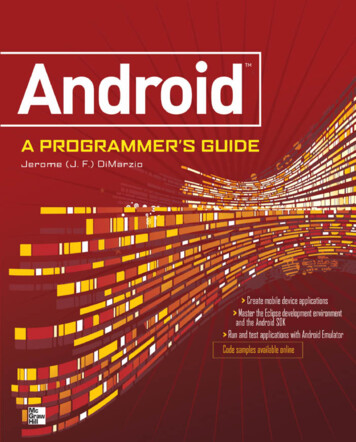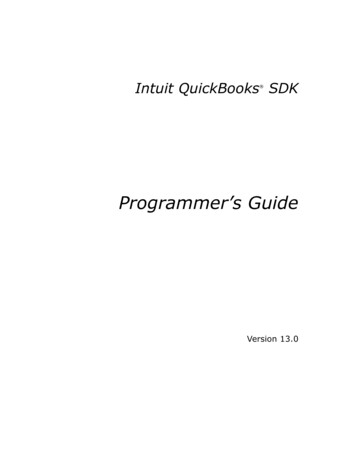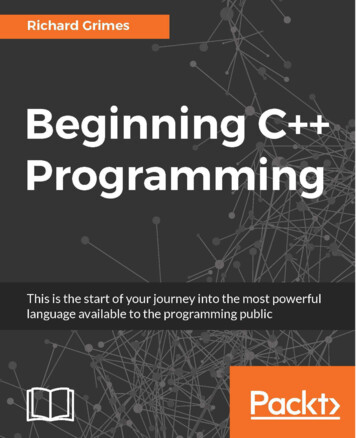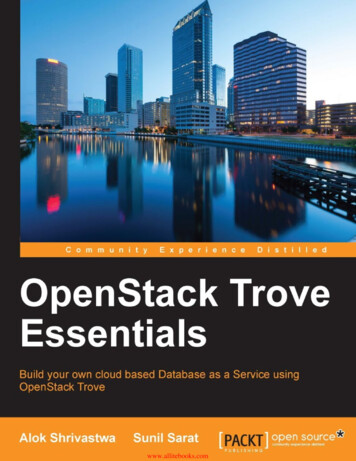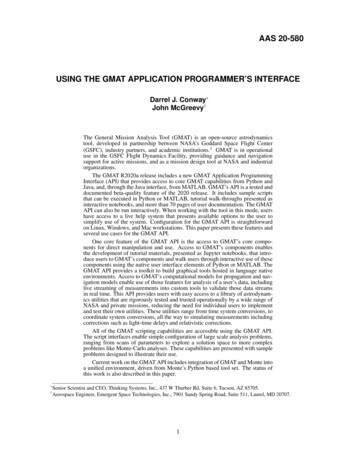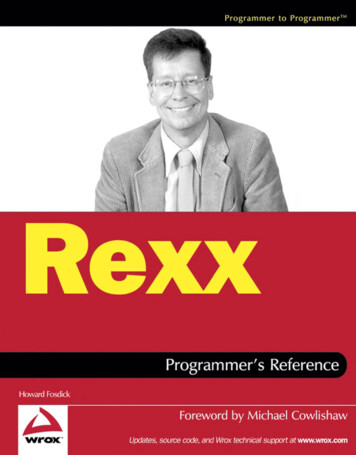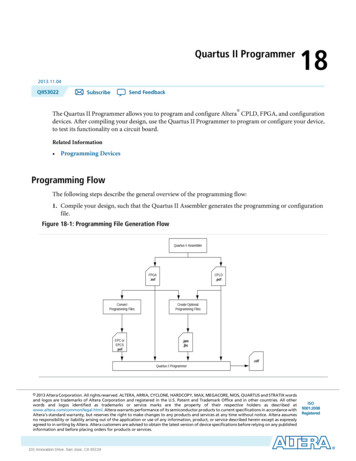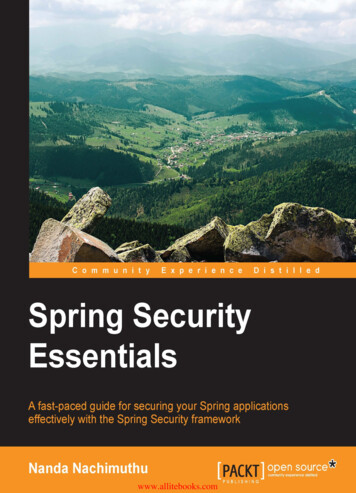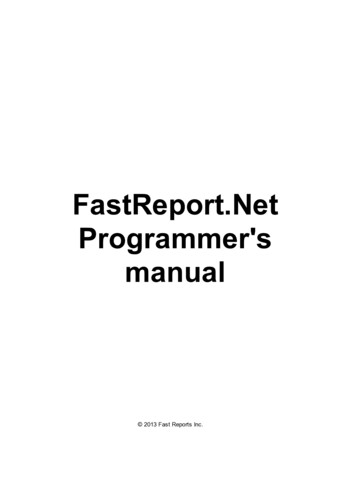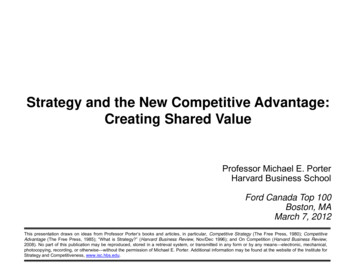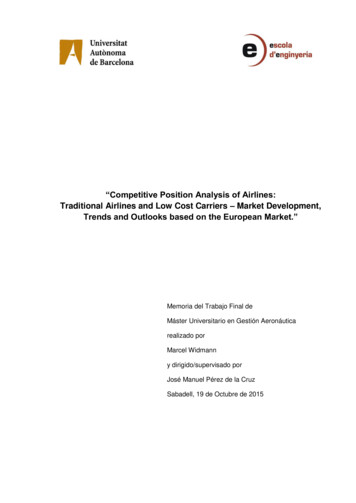
Transcription
Competitive Programmer’s HandbookAntti LaaksonenDraft July 3, 2018
ii
ContentsPrefaceixI1Basic techniques1 Introduction1.1 Programming languages1.2 Input and output . . . . .1.3 Working with numbers .1.4 Shortening code . . . . . .1.5 Mathematics . . . . . . .1.6 Contests and resources .334681015.17172021213 Sorting3.1 Sorting theory . . . . . . . . . . . . . . . . . . . . . . . . . . . . . . . .3.2 Sorting in C . . . . . . . . . . . . . . . . . . . . . . . . . . . . . . .3.3 Binary search . . . . . . . . . . . . . . . . . . . . . . . . . . . . . . . .252529314 Data structures4.1 Dynamic arrays . . . .4.2 Set structures . . . . .4.3 Map structures . . . .4.4 Iterators and ranges .4.5 Other structures . . .4.6 Comparison to sorting2 Time complexity2.1 Calculation rules . . . . .2.2 Complexity classes . . . .2.3 Estimating efficiency . .2.4 Maximum subarray sum.353537383941445 Complete search5.1 Generating subsets . . . .5.2 Generating permutations5.3 Backtracking . . . . . . .5.4 Pruning the search . . . .5.5 Meet in the middle . . . .474749505154.iii
6 Greedy algorithms6.1 Coin problem . . . .6.2 Scheduling . . . . . .6.3 Tasks and deadlines6.4 Minimizing sums . .6.5 Data compression .575758606162.656570717274758 Amortized analysis8.1 Two pointers method . . . . . . . . . . . . . . . . . . . . . . . . . . .8.2 Nearest smaller elements . . . . . . . . . . . . . . . . . . . . . . . . .8.3 Sliding window minimum . . . . . . . . . . . . . . . . . . . . . . . . .777779819 Range queries9.1 Static array queries .9.2 Binary indexed tree .9.3 Segment tree . . . . .9.4 Additional techniques.8384868993.95959698100102.7 Dynamic programming7.1 Coin problem . . . . . . . . . . .7.2 Longest increasing subsequence7.3 Paths in a grid . . . . . . . . . .7.4 Knapsack problems . . . . . . .7.5 Edit distance . . . . . . . . . . .7.6 Counting tilings . . . . . . . . .10 Bit manipulation10.1 Bit representation . . .10.2 Bit operations . . . . . .10.3 Representing sets . . .10.4 Bit optimizations . . . .10.5 Dynamic programmingII.Graph algorithms.10711 Basics of graphs10911.1 Graph terminology . . . . . . . . . . . . . . . . . . . . . . . . . . . . . 10911.2 Graph representation . . . . . . . . . . . . . . . . . . . . . . . . . . . 11312 Graph traversal11712.1 Depth-first search . . . . . . . . . . . . . . . . . . . . . . . . . . . . . 11712.2 Breadth-first search . . . . . . . . . . . . . . . . . . . . . . . . . . . . 11912.3 Applications . . . . . . . . . . . . . . . . . . . . . . . . . . . . . . . . . 121iv
13 Shortest paths13.1 Bellman–Ford algorithm . . . . . . . . . . . . . . . . . . . . . . . . .13.2 Dijkstra’s algorithm . . . . . . . . . . . . . . . . . . . . . . . . . . . .13.3 Floyd–Warshall algorithm . . . . . . . . . . . . . . . . . . . . . . . .12312312612914 Tree algorithms14.1 Tree traversal . .14.2 Diameter . . . . .14.3 All longest paths14.4 Binary trees . . .133134135137139.15 Spanning trees14115.1 Kruskal’s algorithm . . . . . . . . . . . . . . . . . . . . . . . . . . . . 14215.2 Union-find structure . . . . . . . . . . . . . . . . . . . . . . . . . . . . 14515.3 Prim’s algorithm . . . . . . . . . . . . . . . . . . . . . . . . . . . . . . 14716 Directed graphs16.1 Topological sorting . . .16.2 Dynamic programming16.3 Successor paths . . . . .16.4 Cycle detection . . . . .14914915115415517 Strong connectivity15717.1 Kosaraju’s algorithm . . . . . . . . . . . . . . . . . . . . . . . . . . . . 15817.2 2SAT problem . . . . . . . . . . . . . . . . . . . . . . . . . . . . . . . . 16018 Tree queries18.1 Finding ancestors . . . .18.2 Subtrees and paths . . .18.3 Lowest common ancestor18.4 Offline algorithms . . . .19 Paths and circuits19.1 Eulerian paths . . .19.2 Hamiltonian paths .19.3 De Bruijn sequences19.4 Knight’s tours . . . .20 Flows and cuts20.1 Ford–Fulkerson algorithm20.2 Disjoint paths . . . . . . . .20.3 Maximum matchings . . .20.4 Path covers . . . . . . . . .v.163163164167170.173173177178179.181182186187190
IIIAdvanced topics19521 Number theory21.1 Primes and factors .21.2 Modular arithmetic21.3 Solving equations .21.4 Other results . . . .197197201204205.20720821021221421523 Matrices23.1 Operations . . . . . . . . . . . . . . . . . . . . . . . . . . . . . . . . . .23.2 Linear recurrences . . . . . . . . . . . . . . . . . . . . . . . . . . . . .23.3 Graphs and matrices . . . . . . . . . . . . . . . . . . . . . . . . . . .21721722022224 Probability24.1 Calculation . . . . . . .24.2 Events . . . . . . . . . .24.3 Random variables . . .24.4 Markov chains . . . . .24.5 Randomized algorithms.22522522622823023125 Game theory25.1 Game states . . . . . . . . . . . . . . . . . . . . . . . . . . . . . . . . .25.2 Nim game . . . . . . . . . . . . . . . . . . . . . . . . . . . . . . . . . .25.3 Sprague–Grundy theorem . . . . . . . . . . . . . . . . . . . . . . . .23523523723826 String algorithms26.1 String terminology26.2 Trie structure . . .26.3 String hashing . .26.4 Z-algorithm . . . .24324324424524727 Square root algorithms27.1 Combining algorithms . . . . . . . . . . . . . . . . . . . . . . . . . . .27.2 Integer partitions . . . . . . . . . . . . . . . . . . . . . . . . . . . . .27.3 Mo’s algorithm . . . . . . . . . . . . . . . . . . . . . . . . . . . . . . .25125225425528 Segment trees revisited28.1 Lazy propagation . . .28.2 Dynamic trees . . . . .28.3 Data structures . . . .28.4 Two-dimensionality .25725826126326422 Combinatorics22.1 Binomial coefficients22.2 Catalan numbers . .22.3 Inclusion-exclusion .22.4 Burnside’s lemma .22.5 Cayley’s formula . .vi.
29 Geometry29.1 Complex numbers29.2 Points and lines . .29.3 Polygon area . . . .29.4 Distance functions.26526626827127230 Sweep line algorithms27530.1 Intersection points . . . . . . . . . . . . . . . . . . . . . . . . . . . . . 27630.2 Closest pair problem . . . . . . . . . . . . . . . . . . . . . . . . . . . . 27730.3 Convex hull problem . . . . . . . . . . . . . . . . . . . . . . . . . . . . 278Bibliography281vii
viii
PrefaceThe purpose of this book is to give you a thorough introduction to competitiveprogramming. It is assumed that you already know the basics of programming,but no previous background in competitive programming is needed.The book is especially intended for students who want to learn algorithmsand possibly participate in the International Olympiad in Informatics (IOI) or inthe International Collegiate Programming Contest (ICPC). Of course, the book isalso suitable for anybody else interested in competitive programming.It takes a long time to become a good competitive programmer, but it is alsoan opportunity to learn a lot. You can be sure that you will get a good generalunderstanding of algorithms if you spend time reading the book, solving problemsand taking part in contests.The book is under continuous development. You can always send feedback onthe book to ahslaaks@cs.helsinki.fi.Helsinki, July 2018Antti Laaksonenix
x
Part IBasic techniques1
Chapter 1IntroductionCompetitive programming combines two topics: (1) the design of algorithms and(2) the implementation of algorithms.The design of algorithms consists of problem solving and mathematicalthinking. Skills for analyzing problems and solving them creatively are needed.An algorithm for solving a problem has to be both correct and efficient, and thecore of the problem is often about inventing an efficient algorithm.Theoretical knowledge of algorithms is important to competitive programmers.Typically, a solution to a problem is a combination of well-known techniques andnew insights. The techniques that appear in competitive programming also formthe basis for the scientific research of algorithms.The implementation of algorithms requires good programming skills. Incompetitive programming, the solutions are graded by testing an implementedalgorithm using a set of test cases. Thus, it is not enough that the idea of thealgorithm is correct, but the implementation also has to be correct.A good coding style in contests is straightforward and concise. Programsshould be written quickly, because there is not much time available. Unlike intraditional software engineering, the programs are short (usually at most a fewhundred lines of code), and they do not need to be maintained after the contest.Programming languagesAt the moment, the most popular programming languages used in contests areC , Python and Java. For example, in Google Code Jam 2017, among the best3,000 participants, 79 % used C , 16 % used Python and 8 % used Java [29].Some participants also used several languages.Many people think that C is the best choice for a competitive programmer,and C is nearly always available in contest systems. The benefits of using C are that it is a very efficient language and its standard library contains a largecollection of data structures and algorithms.On the other hand, it is good to master several languages and understandtheir strengths. For example, if large integers are needed in the problem, Pythoncan be a good choice, because it contains built-in operations for calculating with3
large integers. Still, most problems in programming contests are set so that usinga specific programming language is not an unfair advantage.All example programs in this book are written in C , and the standardlibrary’s data structures and algorithms are often used. The programs follow theC 11 standard, which can be used in most contests nowadays. If you cannotprogram in C yet, now is a good time to start learning.C code templateA typical C code template for competitive programming looks like this:#include bits/stdc .h using namespace std;int main() {// solution comes here}The #include line at the beginning of the code is a feature of the g compilerthat allows us to include the entire standard library. Thus, it is not needed toseparately include libraries such as iostream, vector and algorithm, but ratherthey are available automatically.The using line declares that the classes and functions of the standard librarycan be used directly in the code. Without the using line we would have to write,for example, std::cout, but now it suffices to write cout.The code can be compiled using the following command:g -std c 11 -O2 -Wall test.cpp -o testThis command produces a binary file test from the source code test.cpp. Thecompiler follows the C 11 standard (-std c 11), optimizes the code (-O2) andshows warnings about possible errors (-Wall).Input and outputIn most contests, standard streams are used for reading input and writing output.In C , the standard streams are cin for input and cout for output. In addition,the C functions scanf and printf can be used.The input for the program usually consists of numbers and strings that areseparated with spaces and newlines. They can be read from the cin stream asfollows:int a, b;string x;cin a b x;4
This kind of code always works, assuming that there is at least one space ornewline between each element in the input. For example, the above code canread both of the following inputs:123 456 monkey123456monkeyThe cout stream is used for output as follows:int a 123, b 456;string x "monkey";cout a " " b " " x "\n";Input and output is sometimes a bottleneck in the program. The followinglines at the beginning of the code make input and output more efficient:ios::sync with stdio(0);cin.tie(0);Note that the newline "\n" works faster than endl, because endl alwayscauses a flush operation.The C functions scanf and printf are an alternative to the C standardstreams. They are usually a bit faster, but they are also more difficult to use. Thefollowing code reads two integ
For example, in Google Code Jam 2017, among the best 3,000 participants, 79 % used C , 16 % used Python and 8 % used Java [29]. Some participants also used several languages. Many people think that C is the best choice for a competitive programmer, and C is nearly always available in contest systems. The benefits of using C are that it is a very efficient language and its standard .
